Overview
To establish oneself as a 3PL company catering to nutraceutical manufacturers, a focus on critical components is essential. These include:
- Warehousing
- Transportation
- Inventory management
- Order fulfillment
All while ensuring compliance with FDA regulations. This article delineates a strategic approach that encompasses:
- Market research
- Business planning
- Infrastructure setup
- Integration of packaging and logistics services
Each element is designed to enhance operational efficiency and address the unique demands of the health supplement industry.
Introduction
Understanding the complexities of the nutraceutical industry is essential for manufacturers aiming to enhance operational efficiency. By exploring the transformative potential of third-party logistics (3PL), businesses can effectively streamline their supply chain processes, encompassing everything from warehousing to order fulfillment.
However, the journey to becoming a 3PL provider prompts critical questions:
- What specific logistical needs do nutraceutical manufacturers possess?
- How can a tailored 3PL model meet these demands effectively?
This guide delves into the necessary steps and considerations for establishing a successful 3PL company within this dynamic sector.
Define the 3PL Business Model
Understanding how to become a 3PL company involves centering the business model on outsourcing transportation and supply chain management functions to specialized providers. This model encompasses essential functions such as warehousing, transportation, inventory management, and order fulfillment, which are critical for nutraceutical manufacturers aiming to enhance operational efficiency. By leveraging a 3PL, companies can streamline their operations and concentrate on core activities like product development and marketing. Key components of the 3PL model include:
- Warehousing: Strategically located facilities are utilized to store products, optimizing shipping times and minimizing delivery delays.
- Transportation: Effective coordination of goods movement from manufacturers to retailers or consumers ensures timely delivery and customer satisfaction.
- Inventory Management: Robust systems track stock levels, preventing shortages or overstock situations that can disrupt operations.
- Order Fulfillment: Efficient picking, packing, and shipping processes are implemented to enhance delivery speed and accuracy.
Statistics indicate that companies utilizing 3PL solutions can significantly reduce transportation expenses and improve quality levels. For instance, businesses partnering with 3PL providers often experience enhanced scalability and flexibility, enabling them to adapt swiftly to market demands. As logistics experts assert, outsourcing logistics functions allows manufacturers to focus on their strengths, such as innovation and customer engagement, rather than becoming mired in complex supply chain challenges.
Western Packaging enhances this model with its integrated filling solutions, which seamlessly connect to its comprehensive 3PL offerings. From powders to gummies and soft-gels, Western Packaging provides personalized packaging solutions that streamline production processes. Companies like Brilliant Fulfillment have achieved remarkable growth by implementing advanced warehouse management systems that optimize operations and improve order accuracy. By understanding these components, manufacturers of health products can figure out how to become a 3PL company that effectively addresses their unique logistical needs.
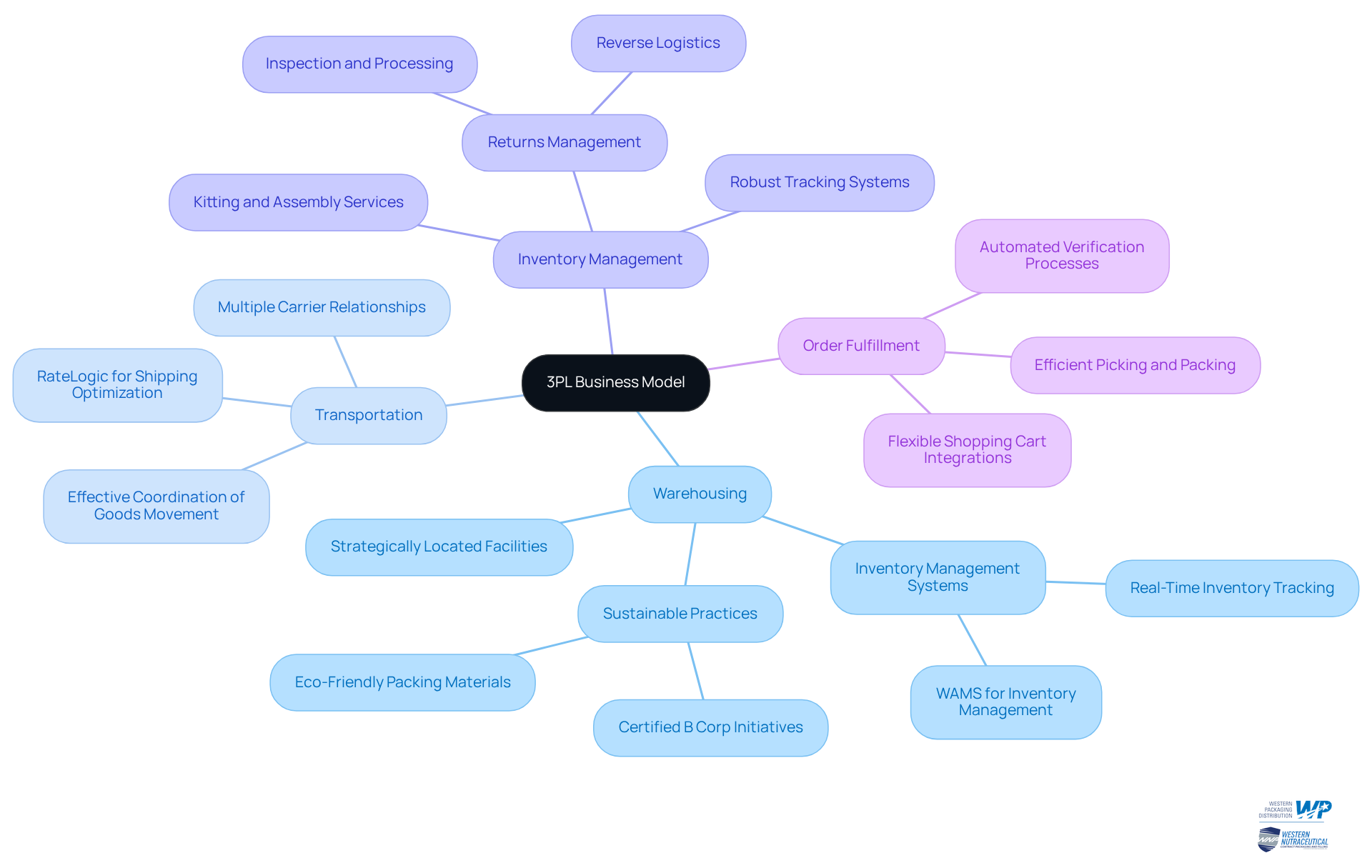
Outline Steps to Start Your 3PL Business
To understand how to become a 3PL company, launching a third-party supply chain (3PL) business in the dietary supplement sector necessitates a strategic approach. Begin with Market Research: conduct a thorough analysis to understand the demand for 3PL offerings within the nutraceutical industry. Identify potential customers and their specific transportation needs, as this will guide your offerings.
Next, focus on Business Plan Development: create a detailed business plan that outlines your offerings, target market, pricing strategy, and financial projections. This plan will serve as a roadmap for your business and is crucial for attracting investors or partners. Consider integrating customized solutions similar to those provided by Western Packaging, which deliver comprehensive support aimed at enhancing supply chain efficiency.
Moving on to Legal Structure and Licensing: decide on a legal structure, such as an LLC or corporation, and secure the necessary licenses and permits to operate as a 3PL provider. This may involve acquiring state-specific transport provider licenses to ensure compliance with regulations.
Then, address Infrastructure Setup: invest in essential infrastructure, including warehousing facilities, transportation vehicles, and advanced technology systems for inventory management and order processing. A well-equipped operation is vital for meeting client expectations and maintaining efficiency. Western Packaging’s comprehensive warehousing and inventory management solutions can serve as a model for your setup.
Next, focus on Personnel: hire skilled individuals, such as supply chain managers, warehouse staff, and client support representatives. An informed team is crucial for providing high-quality service and handling intricate operations.
Finally, develop a Marketing Strategy: create a focused marketing plan to engage health supplement manufacturers. Emphasize your distinctive value proposition, knowledge in the sector, and the advantages of outsourcing transportation to a specialized provider.
By adhering to these steps and considering the extensive 3PL services provided by Western Packaging, you can discover how to become a 3PL company that effectively satisfies the increasing logistics demands of health product manufacturers, ultimately boosting their operational efficiency and market presence.
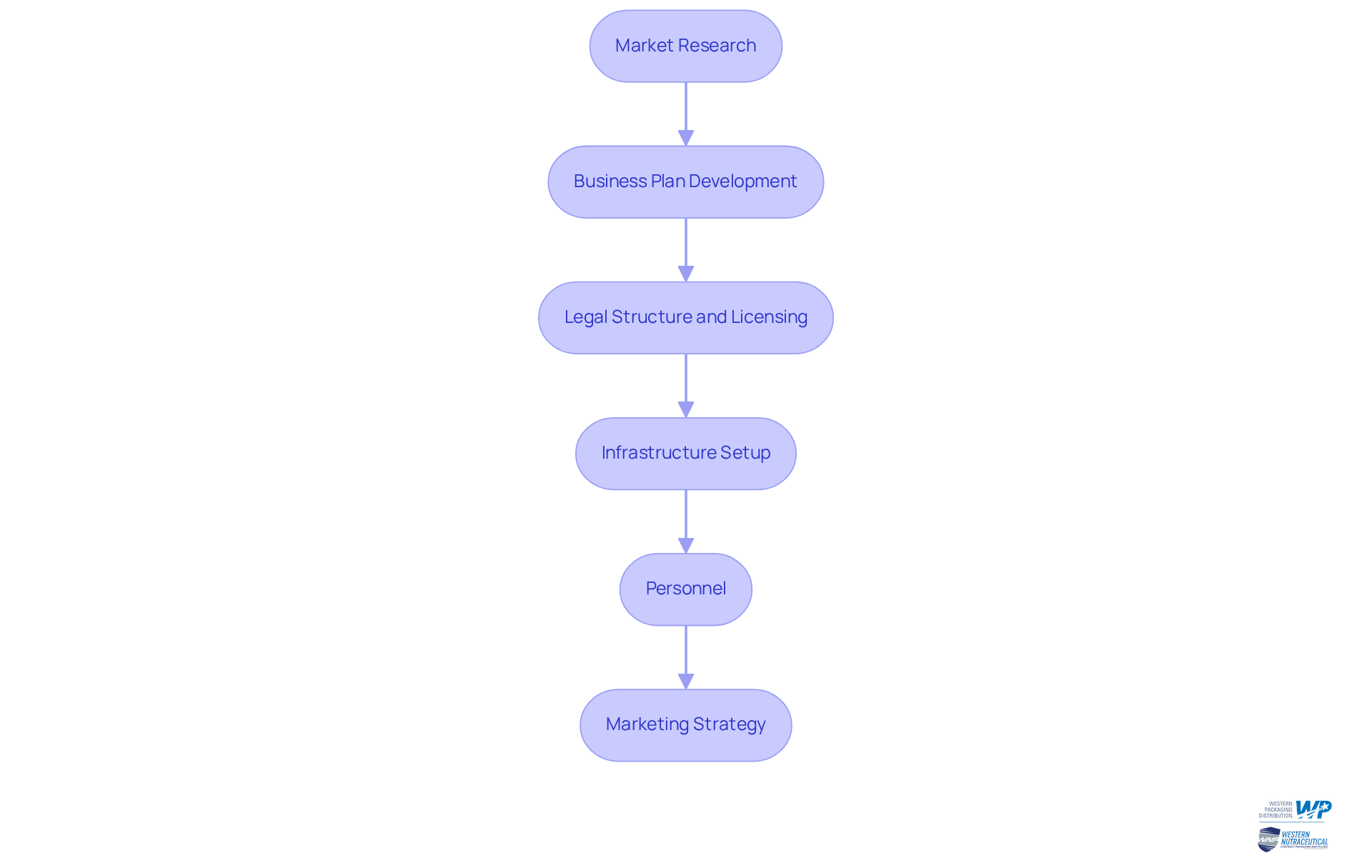
Identify Target Industries and Their Needs
To effectively operate a 3PL business catering to nutraceutical manufacturers, it is crucial to recognize and address their specific logistical needs:
-
Regulatory Compliance: Nutraceuticals are governed by stringent FDA regulations. A successful 3PL must guarantee that all products are stored, handled, and shipped in strict adherence to these guidelines. As Lesley O’Connor, Senior Manager of Regulatory Affairs, emphasizes, "regulatory compliance and brand reputation go hand-in-hand." This highlights the importance of maintaining compliance to avoid costly penalties and protect brand integrity.
-
Temperature Control: Many dietary supplements, such as vitamins and other products, require specific temperature conditions during storage and transportation to maintain their effectiveness. Implementing robust temperature-controlled logistics is essential to ensure product integrity throughout the supply chain.
-
Inventory Management: Nutraceutical companies often manage a diverse array of products, making efficient inventory management systems indispensable. These systems should facilitate accurate tracking of expiration dates and stock levels, thereby minimizing waste and ensuring compliance with regulatory standards. Utilizing warehouse management software can enhance real-time inventory traceability, as noted in industry best practices.
-
Fast Fulfillment: The demand for quick delivery keeps growing in the health supplement industry, particularly as the pandemic has heightened consumer interest in wellness products. A capable 3PL must be equipped to handle high-volume orders and ensure timely shipping, which is critical for meeting customer expectations and maintaining competitive advantage. As Mike Young, Vice President of Sales and Marketing at Vitaquest, states, "Vitaquest has embraced the unexpected by enhancing our planning tools, expanding customer communication, and improving our systems and processes."
By thoroughly grasping these requirements, a 3PL can understand how to become a 3PL company that customizes its offerings to effectively assist manufacturers of health products, improving operational efficiency and compliance.
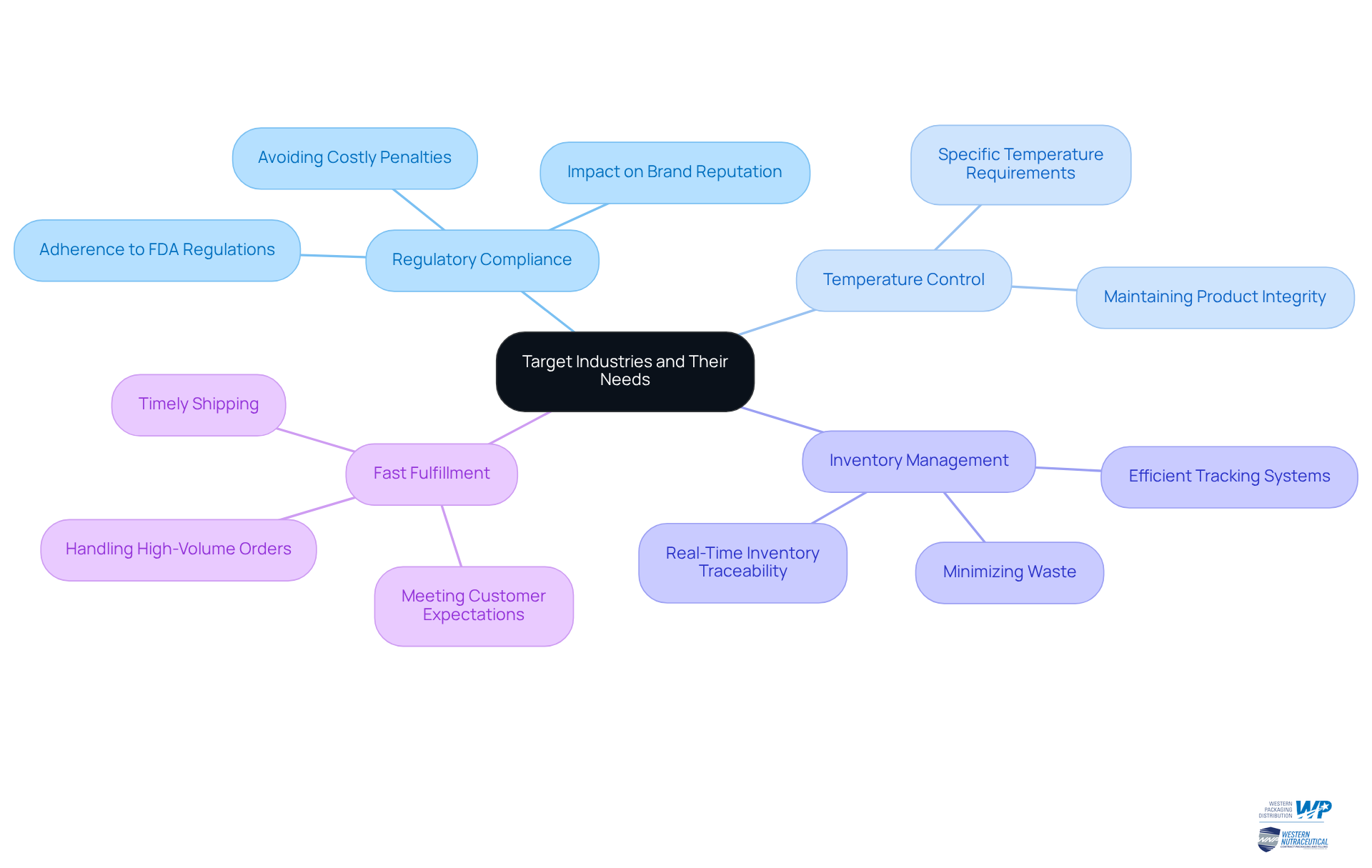
Integrate Packaging and Logistics Services for Efficiency
Combining packaging and transportation services can significantly enhance efficiency within your 3PL operations. Here’s how to achieve this:
-
Collaborative Design: Engage in close collaboration with packaging designers to develop solutions that are visually appealing and optimized for shipping. This method can lead to a reduction in damage during transport, with data indicating that inadequate packaging accounts for a substantial portion of product loss in the health supplement industry. By prioritizing design that considers logistical challenges, you can also improve shelf appeal, making products more attractive to consumers.
-
Streamlined Processes: Establish systems that facilitate seamless communication between packaging and logistics teams. This ensures that packaging adheres to logistical requirements, such as size and weight constraints, which are critical for efficient transportation and storage. A well-coordinated approach can minimize delays and enhance overall operational efficiency.
-
Technology Utilization: Leverage technology to monitor packaging materials and inventory levels in real-time. This capability not only aids in effective stock management but also reduces waste, contributing to a more sustainable operation. Advanced tracking systems can provide insights into inventory turnover and help anticipate demand fluctuations.
-
Sustainability Practices: Explore eco-friendly packaging options that resonate with consumer preferences and comply with regulatory standards. Sustainable practices not only enhance your brand image but also appeal to environmentally conscious clients, which is increasingly important in today’s market.
By integrating these services, you can offer a comprehensive solution to supplement manufacturers, ultimately enhancing their supply chain efficiency and illustrating how to become a 3PL company that is a valuable partner in their growth.
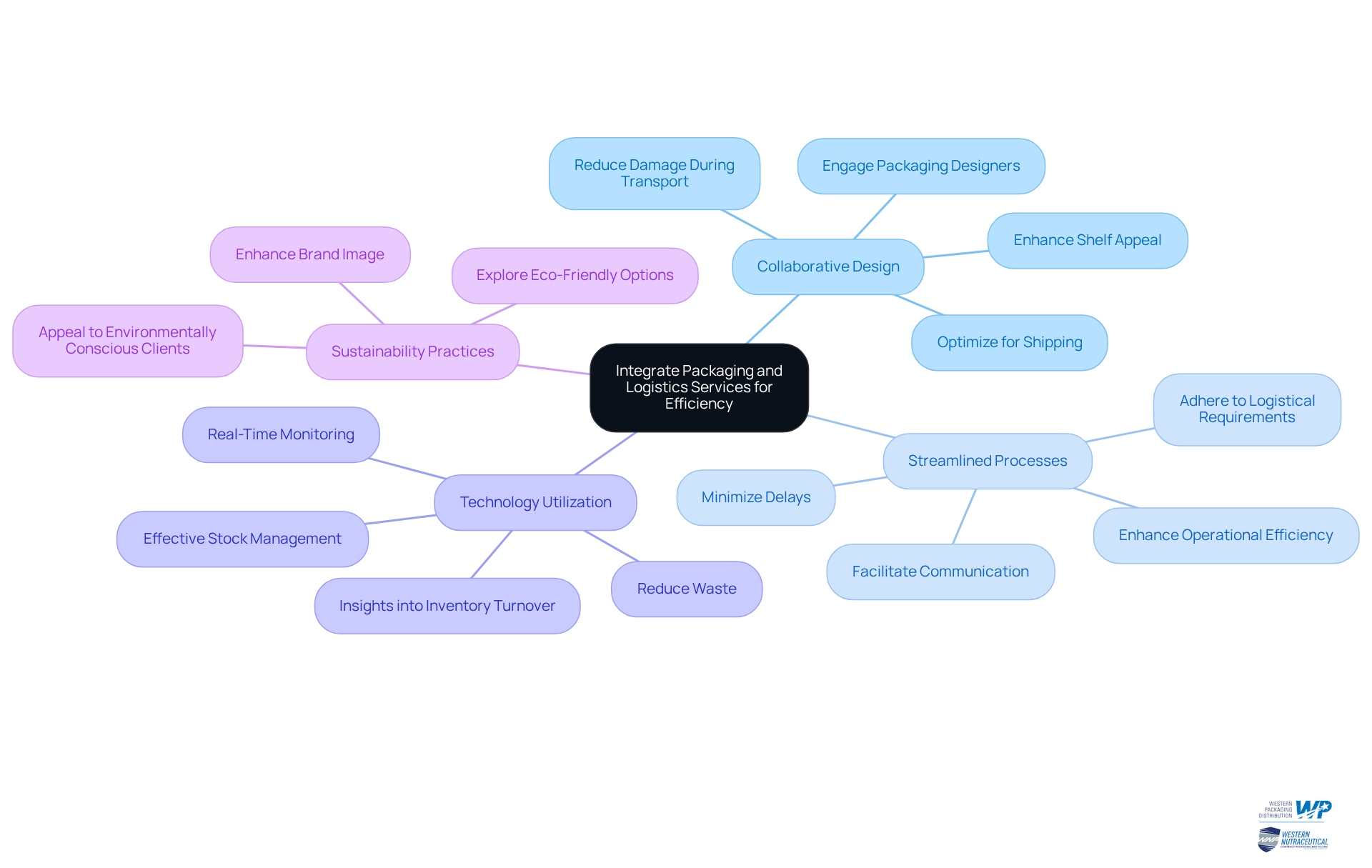
Ensure Regulatory Compliance and Quality Control
Ensuring regulatory compliance and quality control is crucial for a successful 3PL business serving supplement manufacturers. To achieve this, follow these key steps:
-
Understand Regulations: Familiarize yourself with FDA guidelines and Current Good Manufacturing Practices (cGMP) that apply to a wide range of products, including dietary supplements, as well as any state-specific regulations relevant to nutraceuticals. Compliance with these regulations is essential to avoid fines and ensure product safety.
-
Implement Quality Control Systems: Establish robust quality control processes to monitor product integrity throughout the supply chain. This includes regular inspections and testing of products, along with the utilization of Quality Management Systems (QMS) that automate compliance tasks and enhance document management.
-
Training and Certification: Ensure that your staff is well-trained in compliance protocols and understands the importance of maintaining quality standards. Continuous education helps avoid costly mistakes and ensures smooth operations in compliance with cGMP. As ASC Software emphasizes, properly trained personnel are critical for maintaining compliance and ensuring product safety.
-
Documentation and Record-Keeping: Maintain accurate records of all processes, including inventory management, shipping, and quality control checks. This documentation is crucial for audits and regulatory inspections, as it demonstrates adherence to established standards.
-
Continuous Improvement: Regularly review and update your compliance and quality control procedures to adapt to changing regulations and industry standards. As Peter Drucker noted, efficiency should not overshadow the importance of meaningful work; thus, fostering a culture of quality improvement is vital. The health supplement market is rapidly expanding, with online orders up 80% in North America, underscoring the need for effective quality control systems.
By emphasizing adherence and quality, you can understand how to become a 3PL company that meets the high standards expected by dietary supplement manufacturers. This commitment to excellence not only enhances operational efficiency but also strengthens your market presence. For instance, Brilliant Fulfillment achieved significant success in the health and beauty nutraceutical fulfillment space by implementing robust quality control systems, demonstrating the practical benefits of adhering to cGMP standards.
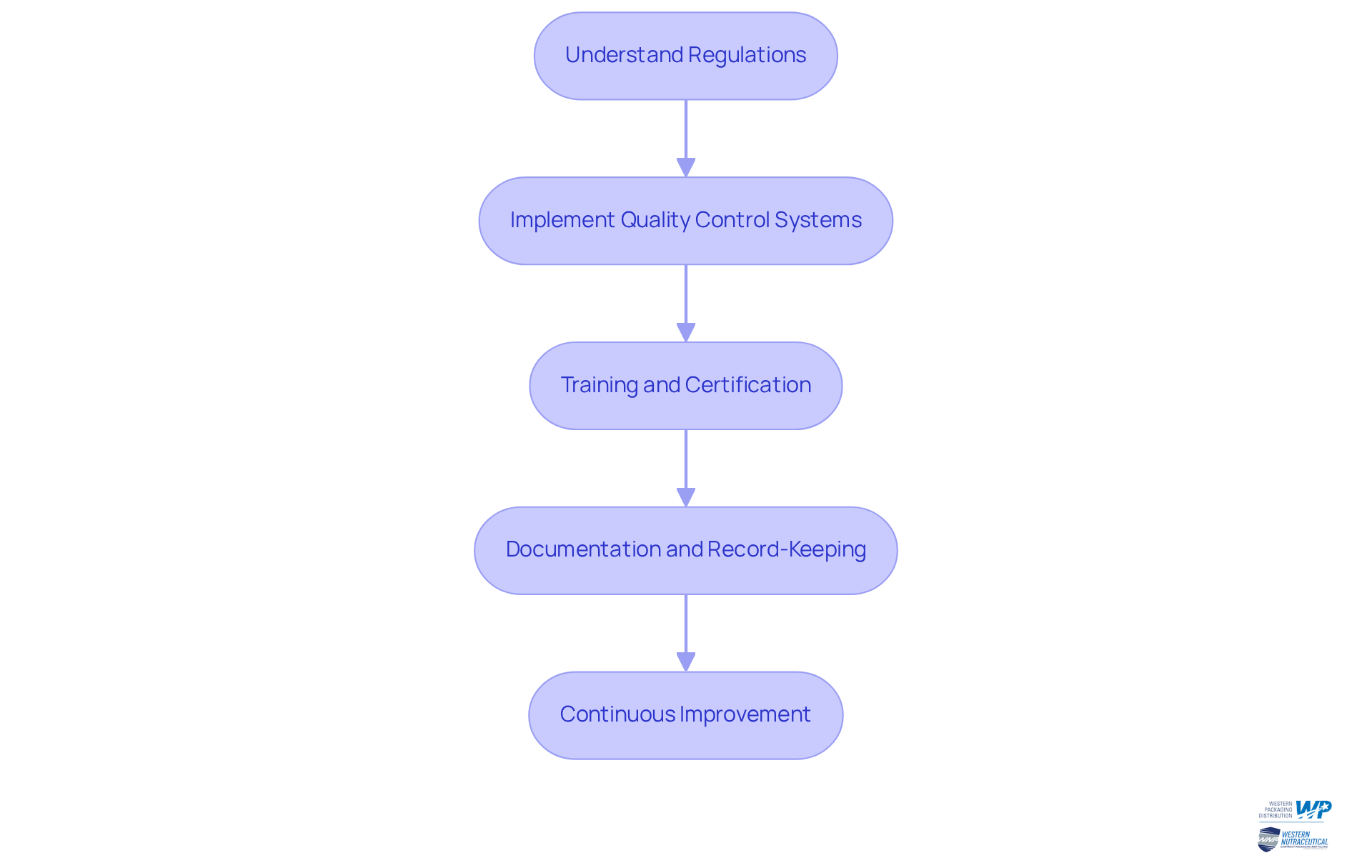
Conclusion
Understanding how to become a 3PL company for nutraceutical manufacturers requires a comprehensive approach that underscores the significance of specialized logistics services tailored to the unique demands of this industry. By adopting a robust third-party logistics model, nutraceutical manufacturers can significantly enhance their operational efficiency. This allows them to concentrate on core business activities while entrusting their supply chain management to seasoned experts.
This article outlines essential steps to establish a successful 3PL business, including:
- Conducting thorough market research
- Developing a solid business plan
- Ensuring regulatory compliance
- Integrating packaging with logistics services for heightened efficiency
Key insights emphasize the necessity of addressing specific logistical needs such as:
- Temperature control
- Inventory management
- Rapid fulfillment
Alongside the importance of maintaining high standards of quality control and compliance with industry regulations.
In conclusion, the journey to becoming a 3PL provider for the nutraceutical sector transcends mere logistics; it is about fostering partnerships that drive growth and operational excellence. By embracing these strategies, businesses can position themselves as invaluable allies to nutraceutical manufacturers, ultimately contributing to their success in an increasingly competitive market. Taking decisive action today by implementing these insights can lead to significant improvements in efficiency and customer satisfaction, thereby reinforcing the vital role of 3PL services in the nutraceutical industry.
Frequently Asked Questions
What is the 3PL business model?
The 3PL business model involves outsourcing transportation and supply chain management functions to specialized providers. It includes key components such as warehousing, transportation, inventory management, and order fulfillment, which help companies enhance operational efficiency.
What are the main functions provided by a 3PL?
The main functions provided by a 3PL include warehousing (storing products), transportation (coordinating goods movement), inventory management (tracking stock levels), and order fulfillment (picking, packing, and shipping products).
How can companies benefit from using a 3PL?
Companies can benefit from using a 3PL by significantly reducing transportation expenses, improving quality levels, enhancing scalability and flexibility, and allowing them to focus on core activities like product development and marketing.
What steps should be taken to start a 3PL business?
To start a 3PL business, one should conduct market research, develop a business plan, decide on a legal structure and obtain necessary licenses, set up infrastructure (warehousing and transportation), hire skilled personnel, and create a marketing strategy.
Why is market research important in starting a 3PL business?
Market research is important because it helps identify the demand for 3PL offerings within the nutraceutical industry and understand potential customers' specific transportation needs, guiding the business's offerings.
What should be included in a business plan for a 3PL company?
A business plan for a 3PL company should outline the offerings, target market, pricing strategy, and financial projections, serving as a roadmap for the business and attracting investors or partners.
What infrastructure is needed to operate a 3PL business?
Essential infrastructure needed includes warehousing facilities, transportation vehicles, and advanced technology systems for inventory management and order processing.
What type of personnel should be hired for a 3PL business?
A 3PL business should hire skilled individuals such as supply chain managers, warehouse staff, and client support representatives to ensure high-quality service and efficient operations.
How can a marketing strategy help a 3PL business?
A marketing strategy can help a 3PL business engage health supplement manufacturers by emphasizing the distinctive value proposition, expertise in the sector, and benefits of outsourcing transportation to a specialized provider.




